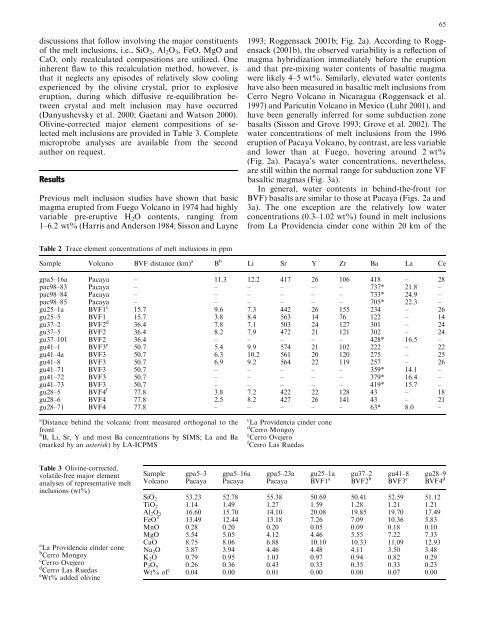The water and trace element contents of melt - Department of ...
The water and trace element contents of melt - Department of ...
The water and trace element contents of melt - Department of ...
You also want an ePaper? Increase the reach of your titles
YUMPU automatically turns print PDFs into web optimized ePapers that Google loves.
discussions that follow involving the major constituents<br />
<strong>of</strong> the <strong>melt</strong> inclusions, i.e., SiO 2,Al 2O 3, FeO, MgO <strong>and</strong><br />
CaO, only recalculated compositions are utilized. One<br />
inherent flaw to this recalculation method, however, is<br />
that it neglects any episodes <strong>of</strong> relatively slow cooling<br />
experienced by the olivine crystal, prior to explosive<br />
eruption, during which diffusive re-equilibration between<br />
crystal <strong>and</strong> <strong>melt</strong> inclusion may have occurred<br />
(Danyushevsky et al. 2000; Gaetani <strong>and</strong> Watson 2000).<br />
Olivine-corrected major <strong>element</strong> compositions <strong>of</strong> selected<br />
<strong>melt</strong> inclusions are provided in Table 3. Complete<br />
microprobe analyses are available from the second<br />
author on request.<br />
Results<br />
Previous <strong>melt</strong> inclusion studies have shown that basic<br />
magma erupted from Fuego Volcano in 1974 had highly<br />
variable pre-eruptive H 2O <strong>contents</strong>, ranging from<br />
1–6.2 wt% (Harris <strong>and</strong> Anderson 1984; Sisson <strong>and</strong> Layne<br />
Table 2 Trace <strong>element</strong> concentrations <strong>of</strong> <strong>melt</strong> inclusions in ppm<br />
Sample Volcano BVF distance (km) a<br />
B b<br />
1993; Roggensack 2001b; Fig. 2a). According to Roggensack<br />
(2001b), the observed variability is a reflection <strong>of</strong><br />
magma hybridization immediately before the eruption<br />
<strong>and</strong> that pre-mixing <strong>water</strong> <strong>contents</strong> <strong>of</strong> basaltic magma<br />
were likely 4–5 wt%. Similarly, elevated <strong>water</strong> <strong>contents</strong><br />
have also been measured in basaltic <strong>melt</strong> inclusions from<br />
Cerro Negro Volcano in Nicaragua (Roggensack et al.<br />
1997) <strong>and</strong> Parı´cutin Volcano in Mexico (Luhr 2001), <strong>and</strong><br />
have been generally inferred for some subduction zone<br />
basalts (Sisson <strong>and</strong> Grove 1993; Grove et al. 2002). <strong>The</strong><br />
<strong>water</strong> concentrations <strong>of</strong> <strong>melt</strong> inclusions from the 1996<br />
eruption <strong>of</strong> Pacaya Volcano, by contrast, are less variable<br />
<strong>and</strong> lower than at Fuego, hovering around 2 wt%<br />
(Fig. 2a). Pacaya’s <strong>water</strong> concentrations, nevertheless,<br />
are still within the normal range for subduction zone VF<br />
basaltic magmas (Fig. 3a).<br />
In general, <strong>water</strong> <strong>contents</strong> in behind-the-front (or<br />
BVF) basalts are similar to those at Pacaya (Figs. 2a <strong>and</strong><br />
3a). <strong>The</strong> one exception are the relatively low <strong>water</strong><br />
concentrations (0.3–1.02 wt%) found in <strong>melt</strong> inclusions<br />
from La Providencia cinder cone within 20 km <strong>of</strong> the<br />
Li Sr Y Zr Ba La Ce<br />
gpa5–16a Pacaya – 11.3 12.2 417 26 106 418 – 28<br />
pac98–83 Pacaya – – – – – – 737* 21.8 –<br />
pac98–84 Pacaya – – – – – – 733* 24.9 –<br />
pac98–85<br />
gu25–1a<br />
Pacaya<br />
BVF1<br />
– – – – – – 705* 22.3 –<br />
c<br />
15.7 9.6 7.3 442 26 155 234 – 26<br />
gu25–5<br />
gu37–2<br />
BVF1<br />
BVF2<br />
15.7 3.8 8.4 563 14 76 122 – 14<br />
d<br />
36.4 7.8 7.1 503 24 127 301 – 24<br />
gu37–5 BVF2 36.4 8.2 7.9 472 21 121 302 – 24<br />
gu37–101 BVF2 36.4 – – – – – 428* 16.5 –<br />
gu41–1 BVF3 e<br />
50.7 5.4 9.9 574 21 102 222 – 22<br />
gu41–4a BVF3 50.7 6.3 10.2 561 20 120 275 – 25<br />
gu41–8 BVF3 50.7 6.9 9.2 564 22 119 257 – 26<br />
gu41–71 BVF3 50.7 – – – – – 359* 14.1 –<br />
gu41–72 BVF3 50.7 – – – – – 379* 16.4 –<br />
gu41–73 BVF3 50.7 – – – – – 419* 15.7 –<br />
gu28–5 BVF4 f<br />
77.8 3.8 7.2 422 22 128 43 – 18<br />
gu28–6 BVF4 77.8 2.5 8.2 427 26 141 43 – 21<br />
gu28–71 BVF4 77.8 – – – – – 63* 8.0 –<br />
a<br />
Distance behind the volcanic front measured orthogonal to the<br />
front<br />
b<br />
B, Li, Sr, Y <strong>and</strong> most Ba concentrations by SIMS; La <strong>and</strong> Ba<br />
(marked by an asterisk) by LA-ICPMS<br />
Table 3 Olivine-corrected,<br />
volatile-free major <strong>element</strong><br />
analyses <strong>of</strong> representative <strong>melt</strong><br />
inclusions (wt%)<br />
a La Providencia cinder cone<br />
b Cerro Mongoy<br />
c Cerro Ovejero<br />
d Cerro Las Ruedas<br />
e Wt% added olivine<br />
c La Providencia cinder cone<br />
d Cerro Mongoy<br />
e Cerro Ovejero<br />
f Cerro Las Ruedas<br />
Sample gpa5–3 gpa5–16a gpa5–23a gu25–1a gu37–2 gu41–8 gu28–9<br />
Volcano Pacaya Pacaya Pacaya BVF1 a<br />
BVF2 b<br />
BVF3 c<br />
BVF4 d<br />
SiO2 53.23 52.78 55.38 50.69 50.41 52.59 51.12<br />
TiO2 1.14 1.49 1.27 1.59 1.28 1.21 1.21<br />
Al2O3 16.60 15.70 14.10 20.08 19.85 19.70 17.49<br />
FeO T<br />
13.49 12.44 13.18 7.26 7.09 10.36 5.83<br />
MnO 0.28 0.20 0.20 0.05 0.09 0.18 0.10<br />
MgO 5.54 5.05 4.12 4.46 5.55 7.22 7.33<br />
CaO 8.75 8.06 6.88 10.10 10.33 11.09 12.93<br />
Na2O 3.87 3.94 4.46 4.48 4.11 3.50 3.48<br />
K2O 0.79 0.95 1.03 0.97 0.94 0.82 0.29<br />
P2O5 0.26 0.36 0.43 0.33 0.35 0.33 0.23<br />
Wt% ol e<br />
0.04 0.00 0.01 0.00 0.00 0.07 0.00<br />
65

















